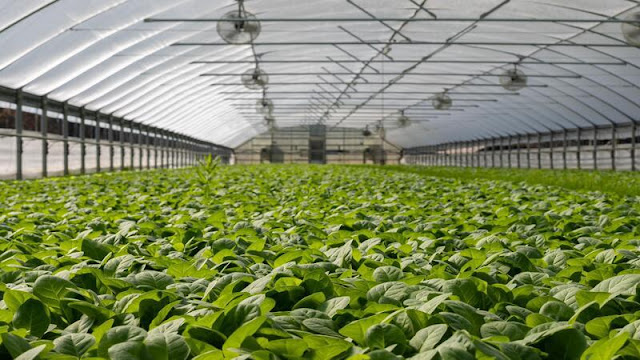Greenhouse Produce: Maximizing Year-Round Crop Yields
 |
| Greenhouse Produce |
Introduction to Greenhouse Growing
Greenhouse farming has become increasingly popular among growers seeking to
maximize production levels and extend growing seasons. By utilizing the
protected environment of a greenhouse structure, farmers are able to carefully
control temperature, light, humidity and other climate variables to stimulate
plant growth. This allows for the successful cultivation of many crops
throughout the winter months and in cooler regions that may have shorter
growing seasons outdoors. Some key advantages of greenhouse growing include:
- Year-round production: With environmental controls, greenhouse crops can be
grown all year without rest periods typically necessitated by wintry weather.
This provides a continuous supply
- Higher yields: Optimal growing conditions translate to larger, healthier
plants and greater crop yields compared to outdoor cultivation in
less-than-ideal climates.
Types of Greenhouse Crops
A variety of vegetables, herbs, fruits and flowers thrive in greenhouse conditions and are widely produced through protected agriculture. Some top greenhouse crops include:
Tomatoes - As one of the most popular greenhouse vegetables, tomatoes enjoy the ideal warm, humid environment of a greenhouse. Growers are able to harvest multiple tomato crops annually versus a single outdoor season.
Cucumbers - Also benefiting from year-round production, cucumbers grow well suspended from the greenhouse structure on trellises. Varieties include slicing, pickling and burpless types.
Bell peppers - Greenhouse peppers mature faster and produce higher yields than in open fields. both sweet and hot pepper varieties are accommodated.
Lettuce - Different lettuce types like romaine, buttercrunch and leaf lettuce grow quickly to harvest in greenhouses, allowing continual cropping.
Herbs - Fresh basil, parsley, cilantro and other culinary herbs flourish when their growing conditions can be closely managed.
Strawberries - By growing strawberries in raised beds within greenhouses, harvests can begin earlier in the season and extend longer compared to usual outdoor growing times.
Poinsettias - A hugely popular Christmas flower, poinsettias are ideally produced for the holiday season in commercial greenhouses from late summer into fall.
Greenhouse Design Features for Optimal Plant
To maximize crop productivity, modern greenhouse structures incorporate various design elements engineered for agricultural use:
Structural materials - Durable frameworks of aluminum, galvanized steel or rigid plastics create stable growing areas optimized for specific climate needs.
Covering materials - Strong but lightweight films, glass or rigid panels admit optimal light levels while retaining heat, carbon dioxide and humidity as needed by plants.
Heating systems - For winter crop production, greenhouses employ fuel-fired or geothermal heaters, boiler systems, hot water pipes or radiant floor heating for frost protection.
Ventilation & cooling - Automatic side vents, evaporative pads or cooling pads prevent stifling temperatures during hot weather while maintaining carbon dioxide levels.
Shade mechanisms - Roll-up shades, retractable curtains or slatted screens deployed on rails tone down intense sunlight to protect delicate crops.
Fertigation systems - Pipes deliver precisely controlled fertilizer solutions incorporating water, oxygen and nutrients directly to roots via drip, mist or boom irrigation.
Bench & flooring designs - Durable benches, slabs, pathways and drainage systems accommodate specialized growing containers, beds, or hydroponic/aquaponic systems tailored for each crop type.
Environmental controls - Computers regulate temperature, humidity, ventilation, lighting, carbon dioxide and other parameters for optimized plant physiological processes year-round.
The Future of Greenhouse Production
As climate change brings more unpredictable weather and shrinking arable land, protected agriculture in greenhouses is poised to play an ever more vital role globally in reliably feeding populations. Advancing technologies will continue driving this industry forward through:
- Automation & robotics - More automated fertilizing, weeding, harvesting and packing reduce labor needs and increase precision.
- Renewable energy integration - Strategies like solar panels help greenhouses operate with less reliance on carbon-intensive fuels.
- Advanced growing systems - New hydroponic, aeroponic and aquaponic methods maximize space and recycle water/nutrients for ulta-efficient crop production.
- Genetic innovations - Plant breeders creating hybrid crops specifically adapted for greenhouse performance will enhance yields.
- Expanded multi-tier designs - Maximizing vertical space through layered shelving or trellising further boosts capacity on existing land areas.
As greenhouse growing optimizes sustainable food production through highly
controlled growing environments, it will remain vitally important to
communities globally both now and into the future facing new environmental
challenges.
Get more
insights, On Greenhouse
Produce



Comments
Post a Comment